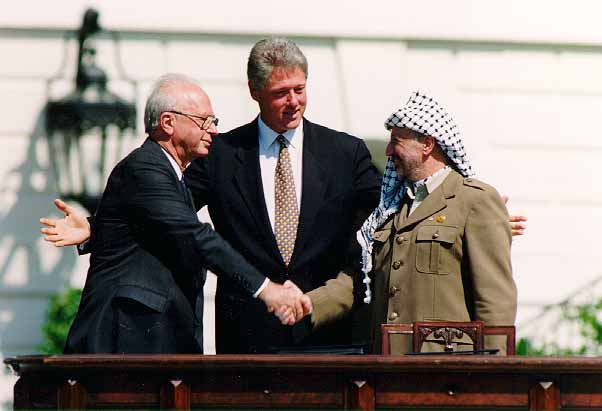Exactly 26 years have passed since Palestinian Liberation Organisation Chairman (PLO), Yasser Arafat, and Israeli Prime Minister, Yitzhak Rabin, reluctantly shook hands on the White House lawn.
Accompanied by solemn vows that the time for peace had come, Rabin and Arafat signed the Declaration of Principles, also known as the Oslo I Accords, on 13 September 1993, marking the formal beginning of the Oslo peace process.
Only days before, both leaders had exchanged the Letters of Mutual Recognition, pursuant to which Israel recognised the PLO as the legitimate representative of the Palestinian people, while the PLO renounced violence, acknowledged Israel’s right to exist, and accepted the principle of territorial compromise.
Oslo was made possible because of a historic “window of opportunity”: the end of the Cold War and, with it, US-Soviet support for proxies throughout the Middle East.
It was a “New World Order” based on collective security and international law, first put to the test during the Gulf War, which saw a coalition of unlikely allies – led by the US and including Hafez al-Assad’s Syria – liberate Kuwait from Iraqi occupation; the sidelining of the PLO, exiled in Tunis, with the outbreak of the First Intifada in the Palestinian Territories, which simultaneously shattered Israel’s illusion that theirs was a “humane occupation” (Shlomo Ben-Ami); and the influx of more than a million Jewish refugees from the former Soviet Union, which decisively shifted Israel’s priorities to economic development.
The Logic of Oslo I
The logic of Oslo was centred around the premise that trust between Israelis and Palestinians could be built incrementally, through a series of agreements which left the most difficult issues for last.
Oslo I established a five-year framework for gradual Israeli withdrawal and Palestinian autonomy, followed by “final status negotiations” concerning Jerusalem, Israeli settlements in the West Bank, security arrangements, final borders, and the right of return of Palestinian refugees.
Initially, the interim agreements were complied with fairly well: the Israeli Defence Force withdrew from Gaza and Jericho, accompanied by popular celebrations; Arafat triumphantly returned to Gaza after decades in exile; Israel concluded a peace treaty with Jordan in 1994, and the same year Rabin, Arafat, and Foreign Minister Shimon Peres were awarded the Nobel Peace Prize.
It is precisely the incremental nature of Oslo, however, which opened the door to spoilers. On both sides, those categorically opposed to any type of settlement resorted to violence in order to derail the peace process.
More Israelis were killed in Palestinian terrorist attacks during the Oslo years than before; Jewish extremism claimed the lives of 29 Muslim worshippers at the Tomb of the Patriarchs in Hebron, and later that of Prime Minister Rabin; all the while, the settler population was increasing steadily.
According to Avi Shlaim, the Oslo process was undermined by the “fatal symmetry of settlements and terrorism.”
Ariel Sharon’s visit to the Temple Mount and the outbreak of the Second Intifada in September 2000, unlikely more violent that the First, sounded the death knell of the peace process.
Much has been written about who should be blamed for the failure of Oslo: was Arafat genuinely willing to agree to a territorial compromise, or was he, as his critics claim, in the end unable to give up his fundamental identity as a freedom fighter, as allegedly evidenced by his rejection of Barak’s peace proposal at Camp David II in 2000?
What would have happened if Rabin had lived, or if, in the elections of 1996, a majority of Israelis had voted for Shimon Peres instead of Benjamin Netanyahu, who paid mere lip service to the agreements?
There can be no satisfactory answer, as we are concerned with historical counterfactuals. There is, however, one question which merits consideration in light of the desolate status quo: what remains of Oslo today?
While the Oslo Accords failed to usher in an era of peace, let alone lead to the establishment of an independent Palestinian state, they nonetheless marked a fundamental transformation of the Israeli-Palestinian conflict.
Every Prime Minister after Rabin has shaken the hand of his Palestinian counterpart; and while support for a two-state solution might be dwindling, most parties on either side – and the international community – recognise, for better or worse, the principle of territorial compromise.
For all this, Oslo paved the way. Therefore, one should remain hopeful that, should the right circumstances be aligned, the “spirit of Oslo” can be revived. Until then, let us enjoy the view from nowhere.
Anna-Christina Schmidl


